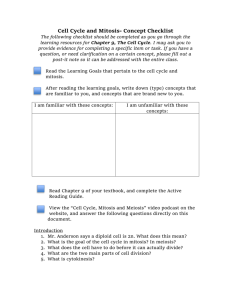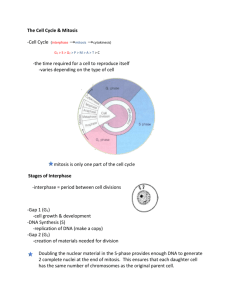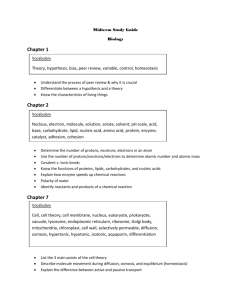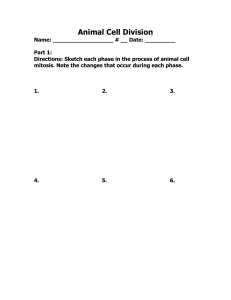5E Lesson Plan on Mitosis and Meiosis
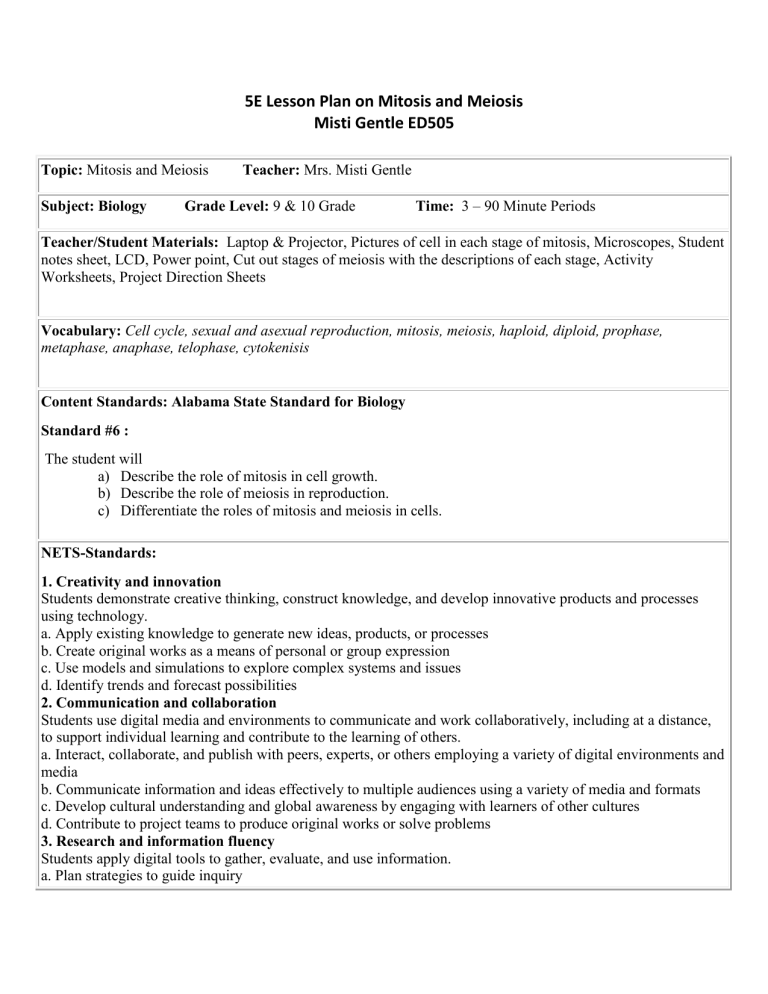
5E Lesson Plan on Mitosis and Meiosis
Misti Gentle ED505
Topic: Mitosis and Meiosis Teacher: Mrs. Misti Gentle
Subject: Biology Grade Level: 9 & 10 Grade Time: 3 – 90 Minute Periods
Teacher/Student Materials: Laptop & Projector, Pictures of cell in each stage of mitosis, Microscopes, Student notes sheet, LCD, Power point, Cut out stages of meiosis with the descriptions of each stage, Activity
Worksheets, Project Direction Sheets
Vocabulary: Cell cycle, sexual and asexual reproduction, mitosis, meiosis, haploid, diploid, prophase, metaphase, anaphase, telophase, cytokenisis
Content Standards: Alabama State Standard for Biology
Standard #6 :
The student will a) Describe the role of mitosis in cell growth. b) Describe the role of meiosis in reproduction. c) Differentiate the roles of mitosis and meiosis in cells.
NETS-Standards:
1. Creativity and innovation
Students demonstrate creative thinking, construct knowledge, and develop innovative products and processes using technology. a. Apply existing knowledge to generate new ideas, products, or processes b. Create original works as a means of personal or group expression c. Use models and simulations to explore complex systems and issues d. Identify trends and forecast possibilities
2. Communication and collaboration
Students use digital media and environments to communicate and work collaboratively, including at a distance, to support individual learning and contribute to the learning of others. a. Interact, collaborate, and publish with peers, experts, or others employing a variety of digital environments and media b. Communicate information and ideas effectively to multiple audiences using a variety of media and formats c. Develop cultural understanding and global awareness by engaging with learners of other cultures d. Contribute to project teams to produce original works or solve problems
3. Research and information fluency
Students apply digital tools to gather, evaluate, and use information. a. Plan strategies to guide inquiry
b. Locate, organize, analyze, evaluate, synthesize, and ethically use information from a variety of sources and media c. Evaluate and select information sources and digital tools based on the appropriateness to specific tasks d. Process data and report results
4. Critical thinking, problem solving, and decision making
Students use critical thinking skills to plan and conduct research, manage projects, solve problems, and make informed decisions using appropriate digital tools and resources. a. Identify and define authentic problems and significant questions for investigation b. Plan and manage activities to develop a solution or complete a project c. Collect and analyze data to identify solutions and/or make informed decisions d. Use multiple processes and diverse perspectives to explore alternative solutions
5. Digital citizenship
Students understand human, cultural, and societal issues related to technology and practice legal and ethical behavior. a. Advocate and practice safe, legal, and responsible use of information and technology b. Exhibit a positive attitude toward using technology that supports collaboration, learning, and productivity c. Demonstrate personal responsibility for lifelong learning d. Exhibit leadership for digital citizenship
6. Technology operations and concepts
Students demonstrate a sound understanding of technology concepts, systems, and operations. a. Understand and use technology systems b. Select and use applications effectively and productively c. Troubleshoot systems and applications d. Transfer current knowledge to learning of new technologies
Lesson Objective(s): Bio.6.B, Bio.6.B.1, Bio.6.B.2
a.
Compare and contrast the processes of mitosis and meiosis and their significance to asexual and sexual reproduction. b.
Comparing sperm and egg formation in terms of haploid and diploid. c.
Differentiate the phases of mitosis and meiosis.
Differentiation Strategies to meet Diverse Learner Needs: Mixed Ability Groups
Verbal-Linguistic: Students will discuss in groups the process of mitosis and meiosis.
Logical/Mathematical: Students will learn the breakdown of chromosomes and how it is different in mitosis and meiosis through graphic organizers.
Visual/Spatial: Students will create a model of each of the stages of mitosis to have a flow chart for.
Naturalist: Students will observe slides of onion root tip cells to see the actual real life cells dividing under a microscope.
Intrapersonal: Students will be asked to explain one impact that mitosis or meiosis is being used for outside the body.
Interpersonal : Students will work in groups to work on their flow charts.
Modifications/Accommodations:
I will review student’s IEP, 504 or ELL(WIDA)and make appropriate modifications and accommodations.
Absent : If students are absent they will look at the flow charts and graphic organizers that students made in inspiration and create their own for homework.
ENGAGEMENT:
Students will view a picture of a hydra budding and of two beetles mating. The students discuss the question as a class “What is the difference between the hydra’s offspring and the beetle’s offspring?” http://www.dnatube.com/video/11330/Reproduction-Of-Hydra www.youtube.com/watch?v=Bh_tDCxbBOQ
Students also come up with ideas about how a cell could make an exact copy of itself after watching the video below. www.youtube.com/watch?v=W4vOPaonZng
EXPLORATION:
Students view eight pictures of actual cells going through mitosis taken from www.sciencephotolibrary.com.
Using a diagram of mitosis as a guide, the students try to identify the stages of mitosis in each picture, recording this information in their science interactive notebooks. After completing this step, students view cells undergoing mitosis through the mitosis. http://micro.magnet.fsu.edu/micro/gallery/mitosis/mitosis.html. Next to each microscope, place a labeled diagram of mitosis so students can verify which stage of cell division they are observing. If you have limited number of microscopes or slides, set up the pictures and microscopes at the same time and have students complete rotation of the microscope stations.
EXPLANATION:
Students record notes in their interactive notebook as the teacher leads the discussion of mitosis and cell division using a PowerPoint presentation. www.biologyjunction.com/ cell %20cycle%20&%20 cell %20 division .htm .
During the lesson, the students can check their work that was completed during the explore stage of the lesson.
The discussion of mitosis and cell cycle also includes a discussion of cancer, which makes a real life connection for students. The importance of mitosis and meiosis in asexual and sexual reproduction is the focus of the
PowerPoint and storyboard.
ELABORATION:
Provided a template and cut out models of cells in different stages of meiosis, students sequence the stages of meiosis working with their groups using an interactive game. http://www.cellsalive.com/meiosis.htm
After correctly sequencing their stages, the students answer the following questions with their group in a storyboard format using http://www.storyboardthat.com/: a) How is Meiosis I similar to and different from mitosis? b) How is Meiosis II similar to and different from mitosis? c) Why is Meiosis important to living things? d) Compare and contrast mitosis and meiosis?
To facilitate the comparison of mitosis and meiosis provide students with a graphic organizer to use once they have created a sequence for the cell models illustrating meiosis.
EVALUATION:
Students complete an individual project in which they can choose five different ways of representing that they understand the similarities and differences between mitosis and meiosis. These include illustration, writing a story, poem, or song, performing a skit, or creating a PowerPoint or using another source of technology they choose. file:///C:/Users/teacher/Downloads/Rubric%20for%20ED505.htm

